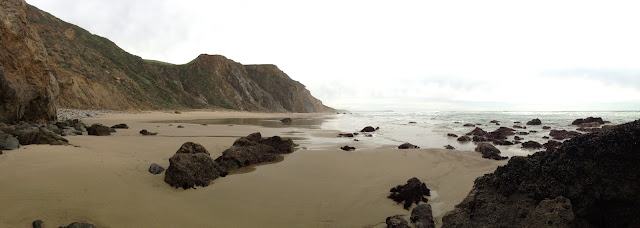They are available now — order on line and coming soon to vendors in California.
Judith was sorry to have missed Doug's visit. She made a quick stop at Kehoe Beach to check on the status of the plastic before heading to the closing reception of Commons Dilemma at Gallery Route One. Gravitational moon sway makes it the season for the lowest of the low tides and the highest of high tides of the year. And the low did not disappoint.
Plus there was plenty of plastic in eye-catching complementary color arrangements:

At Gallery Route One The Ostrich Feather Wedding Dress Project was organized by Lorna Stevens and Joanne Easton in conjunction with their exhibit Commons Dilemma. Research into the history of the ostrich and use of their feathers are adornment led them to acquire on E-Bay an ostrich feather wedding dress. They were fascinated by this gown and offered it as a launch point for a group project. Each artist borrowed the dress for one week and created an art work in response.
Judith writes:
When I think about the journey of my snarl of rope — from the Pacific Ocean to Kehoe Beach to the wall at Gallery Route One — to see that "mess" presented in a formal setting — I really have to smile. When I think about the transgressive gesture of posing trash as treasure, I was delighted to see that alongside the remarkable offerings of my esteemed colleagues, it held its own.
As "found art" my contribution titled What goes round was doubly found — it was first found on Kehoe Beach, then in response to Lorna and Jo's request, found again in our welter of ropes and piles of fishing nets. In my studio, to reference the ostrich feather cowl on the wedding dress, I arranged the ready-made rope into a cowl and added it to the history, origins and definitions of found art, objet trouvé, assemblage and all manner of trash into treasure — from Duchamp's Fountain and the combines of Rauschenberg to the recent phenomena of upcycled Trashion fashion shows.
From a distance the oval snarl of unraveling rope and derelict fishing gear looks like a flurry of feathers and is an inspired response to the ruff of feathers on the wedding dress. As distinctive and luxurious gift from the sea it is also a reminder of the problem of commercial overfishing, by-catch and whale entanglement. Buffeted by wind and surf, much of its beauty is the result of natural forces, plus there is mystique of its odyssey from ocean to beach.
Wearing a piece of beach plastic as jewelry becomes a talking point, a statement of fashion, about what is happening on the beach and in the ocean. Crafting the debris into fine-art-wear as jewelry and garments has become an important part of my art practice. While the content of my work has a message about the spoiling of the natural world by the human/industrial world, my intent is to transform the perils of pollution into something beautiful and celebratory. By putting a little fun and fashion into the conservation conversation, I hope that the value of detritus will increase. Soon everyone will be out at the beach “shopping” for a special piece of plastic trash or will be eager to “mine” the North Pacific Gyre for plastic treasures. Then, we get some great things to wear and to look at, plus we get a clean and healthy sea.










